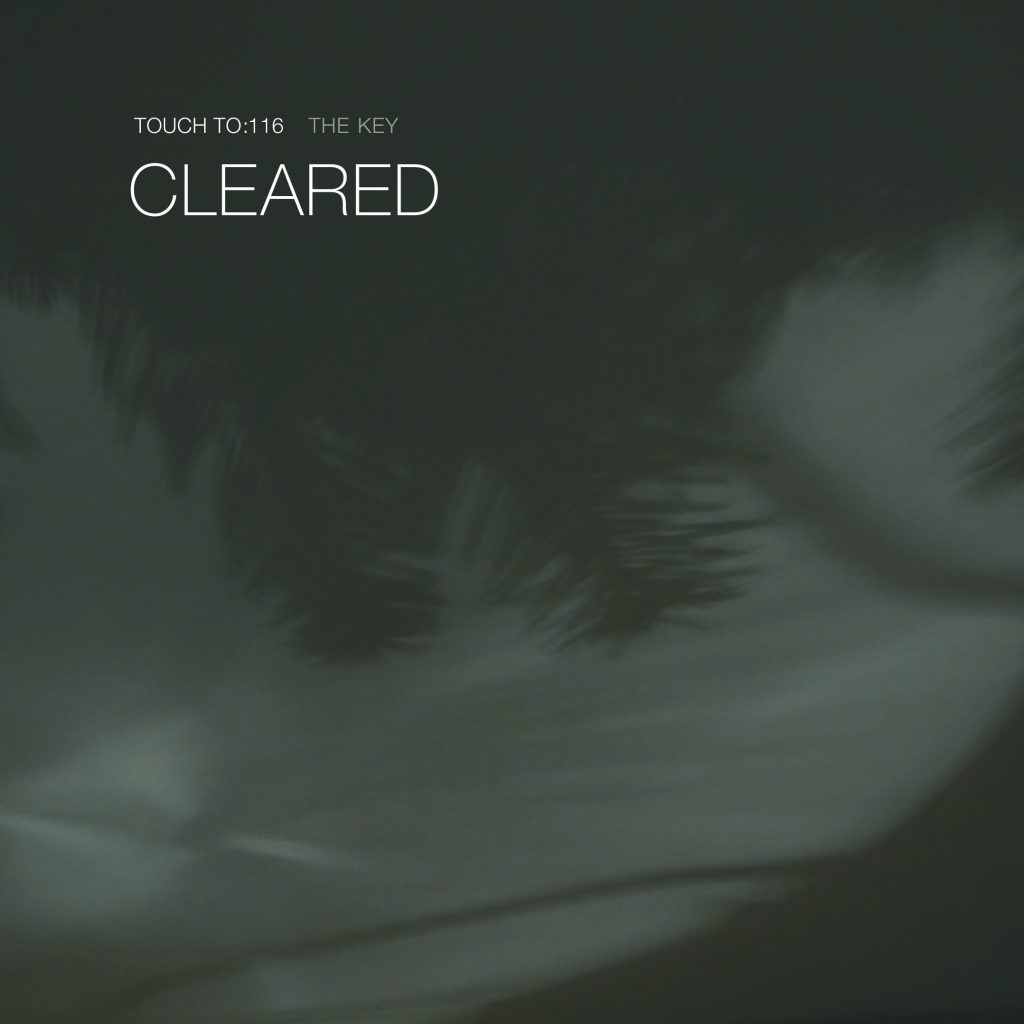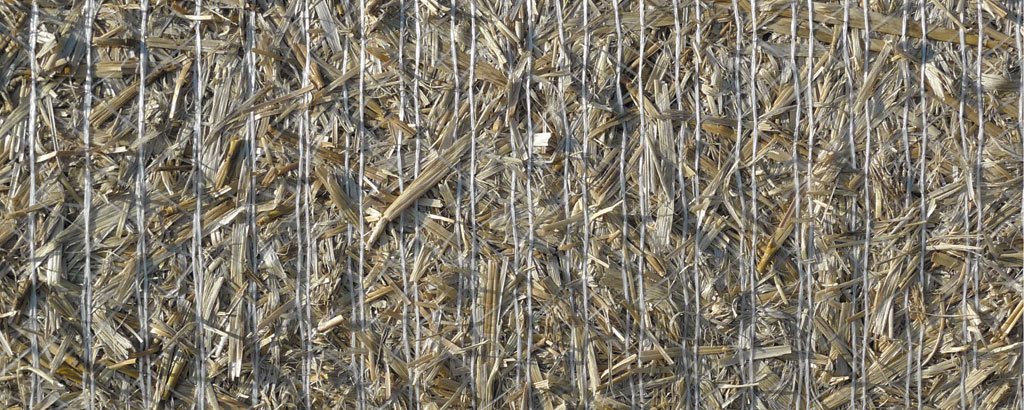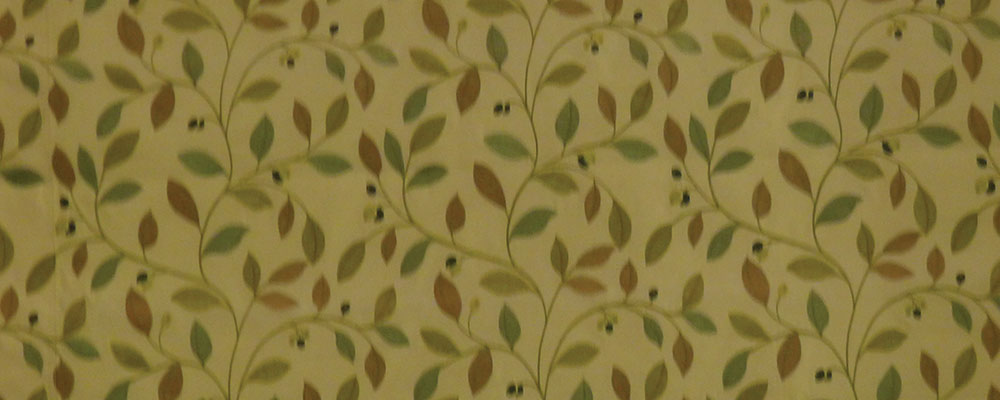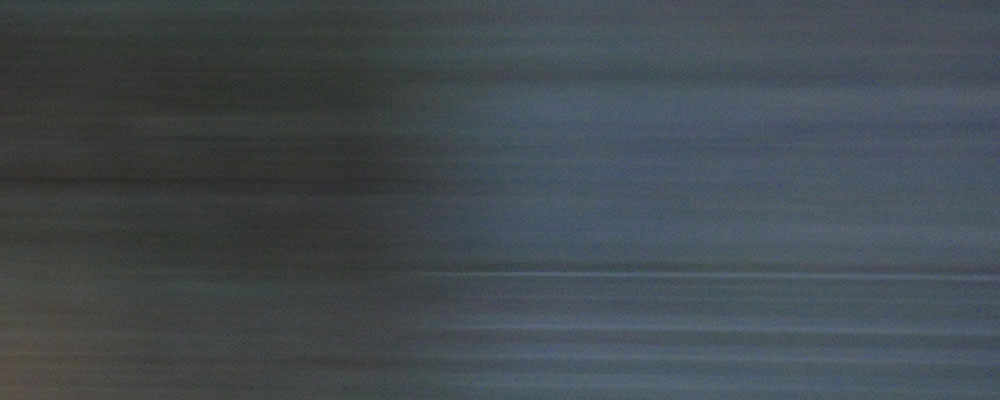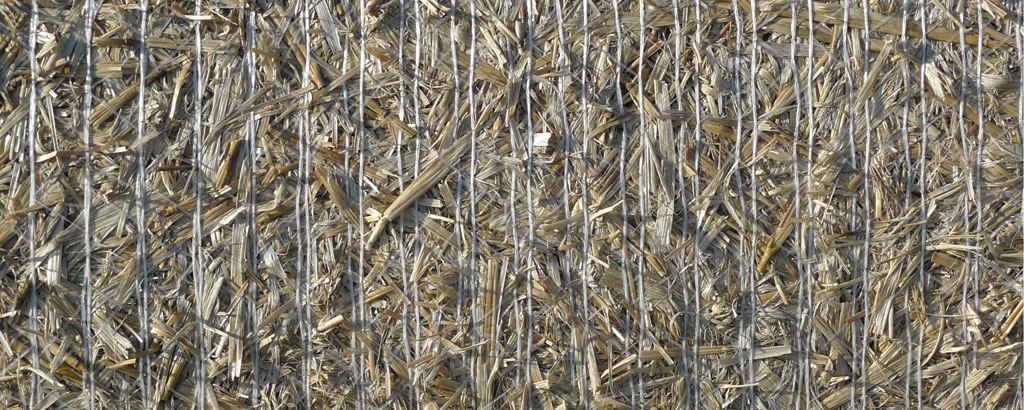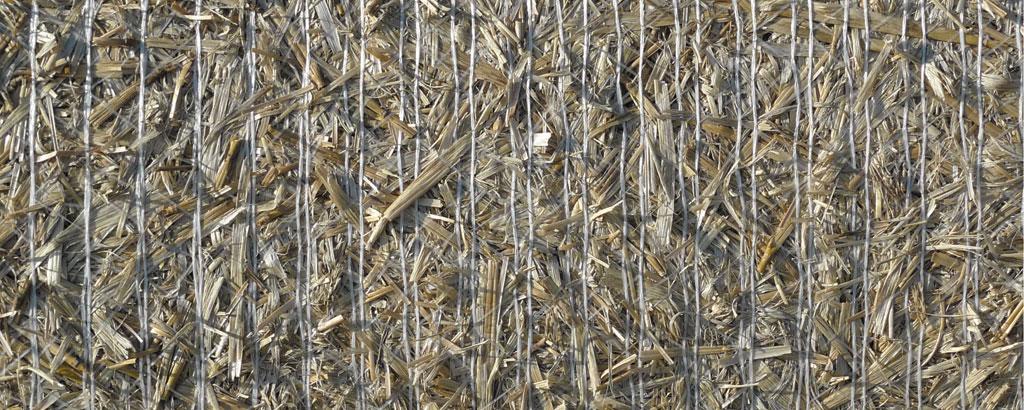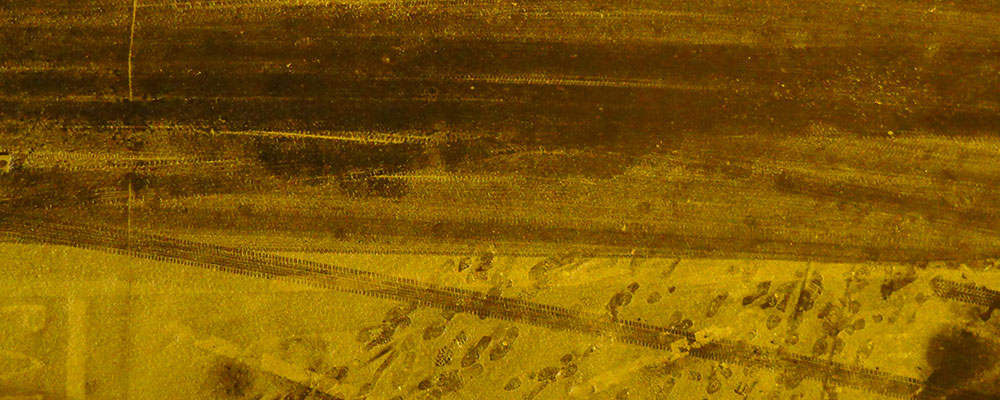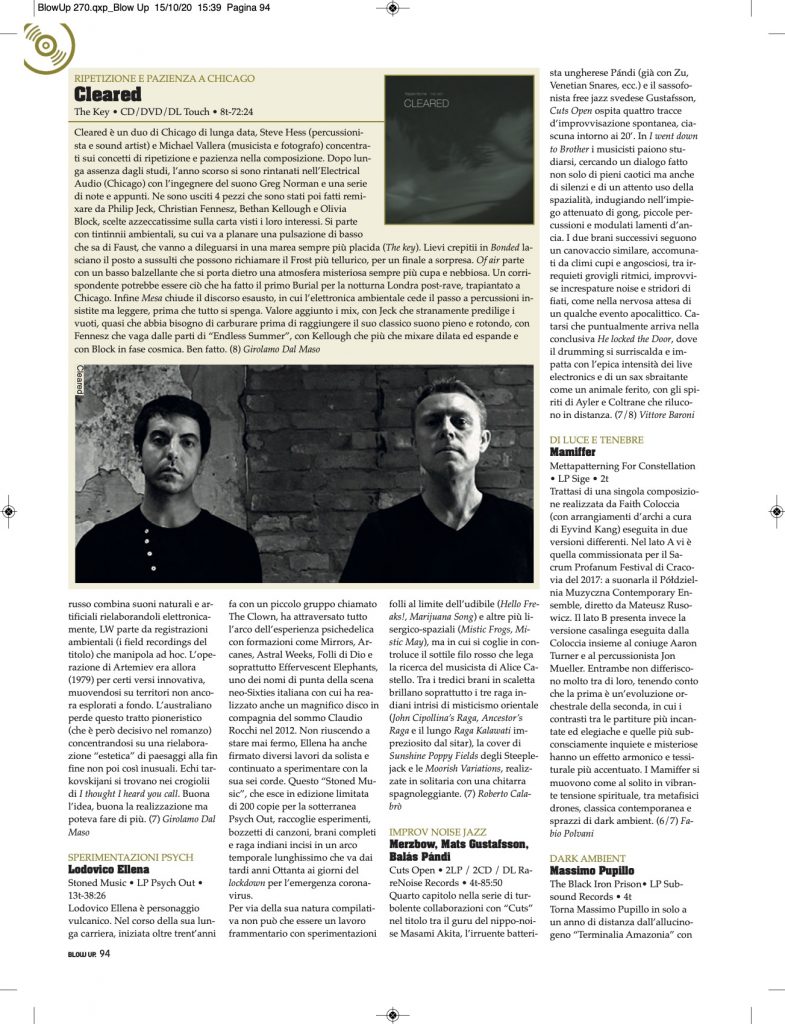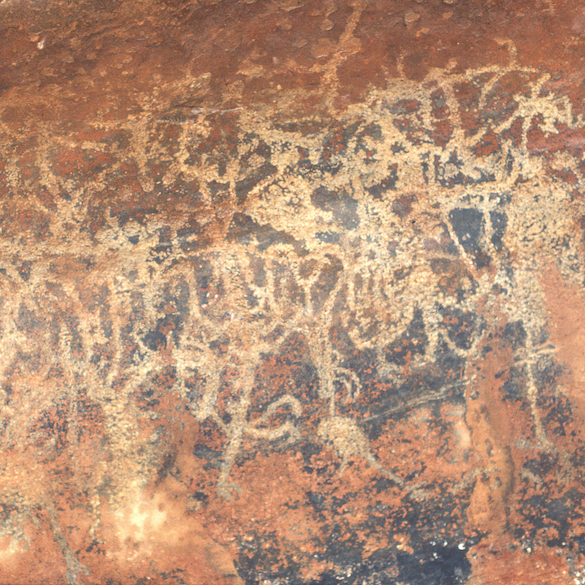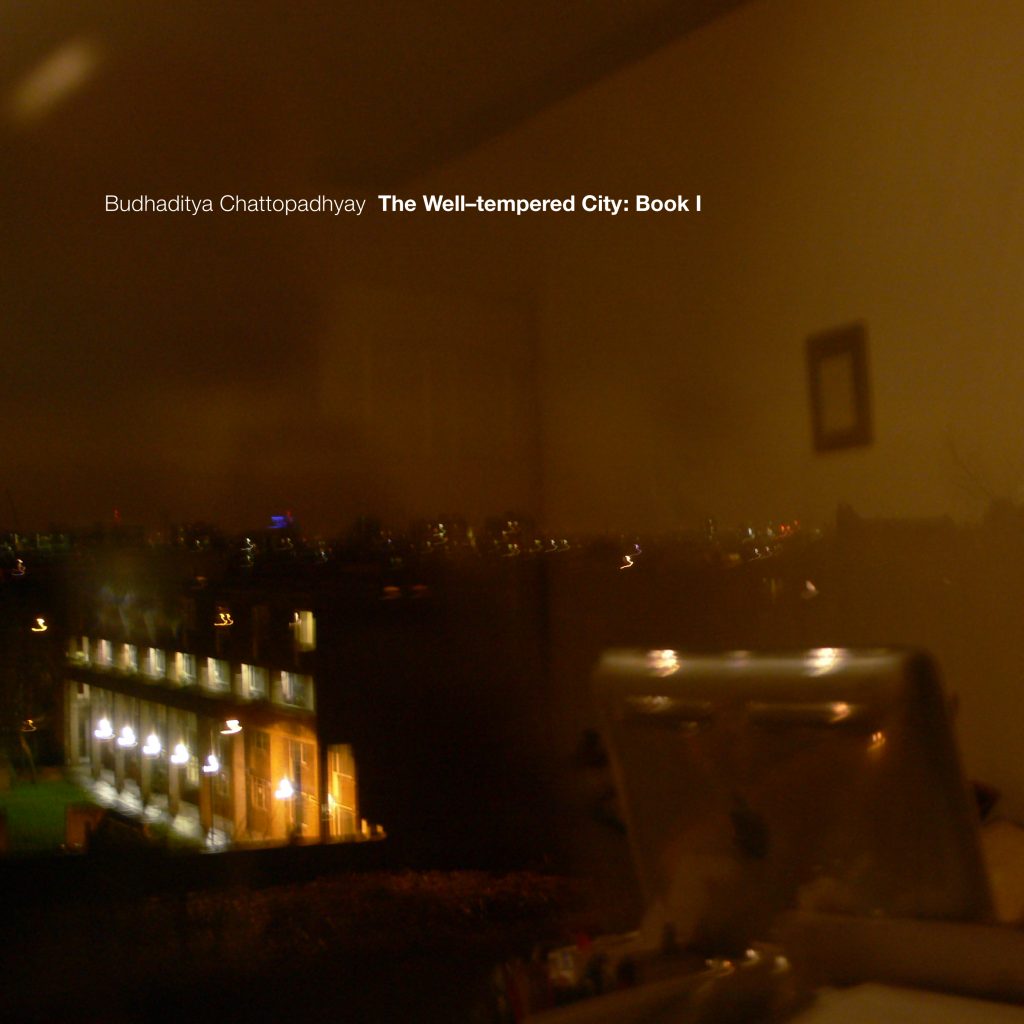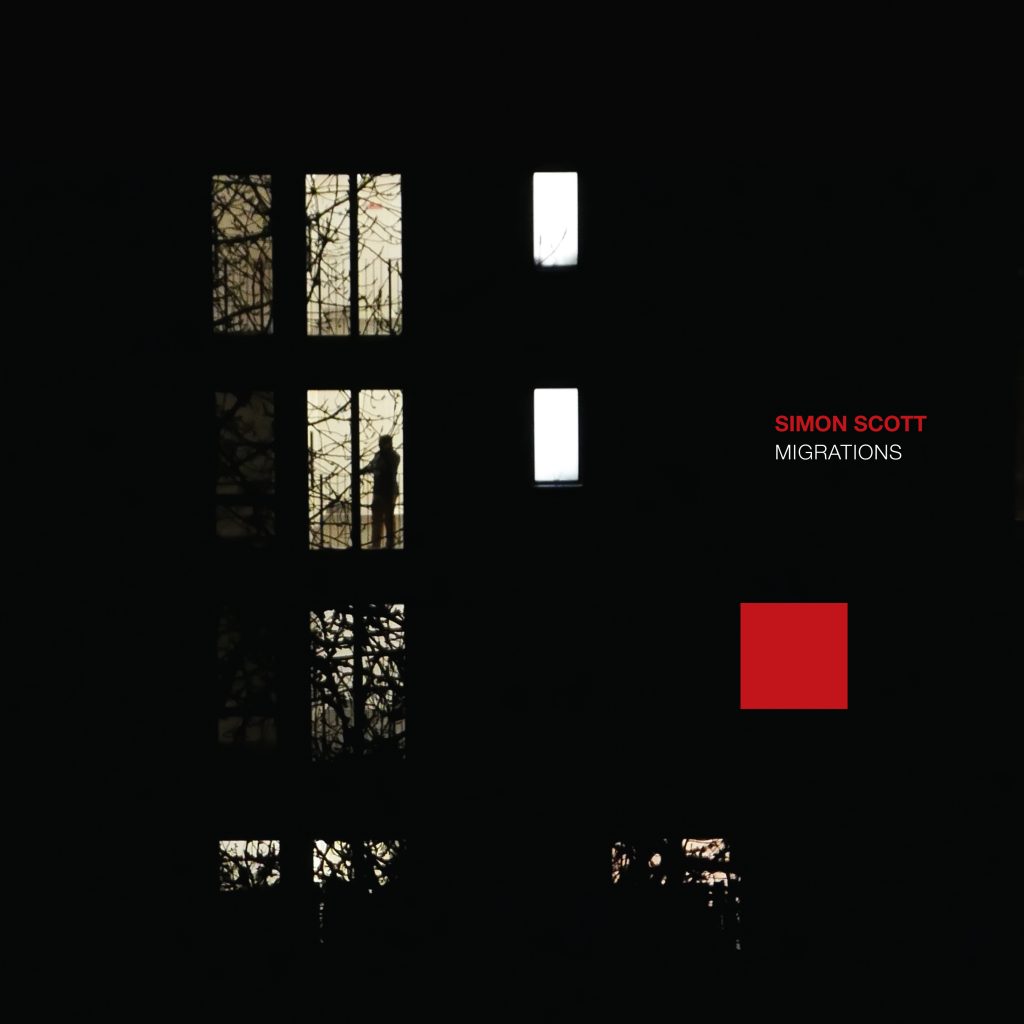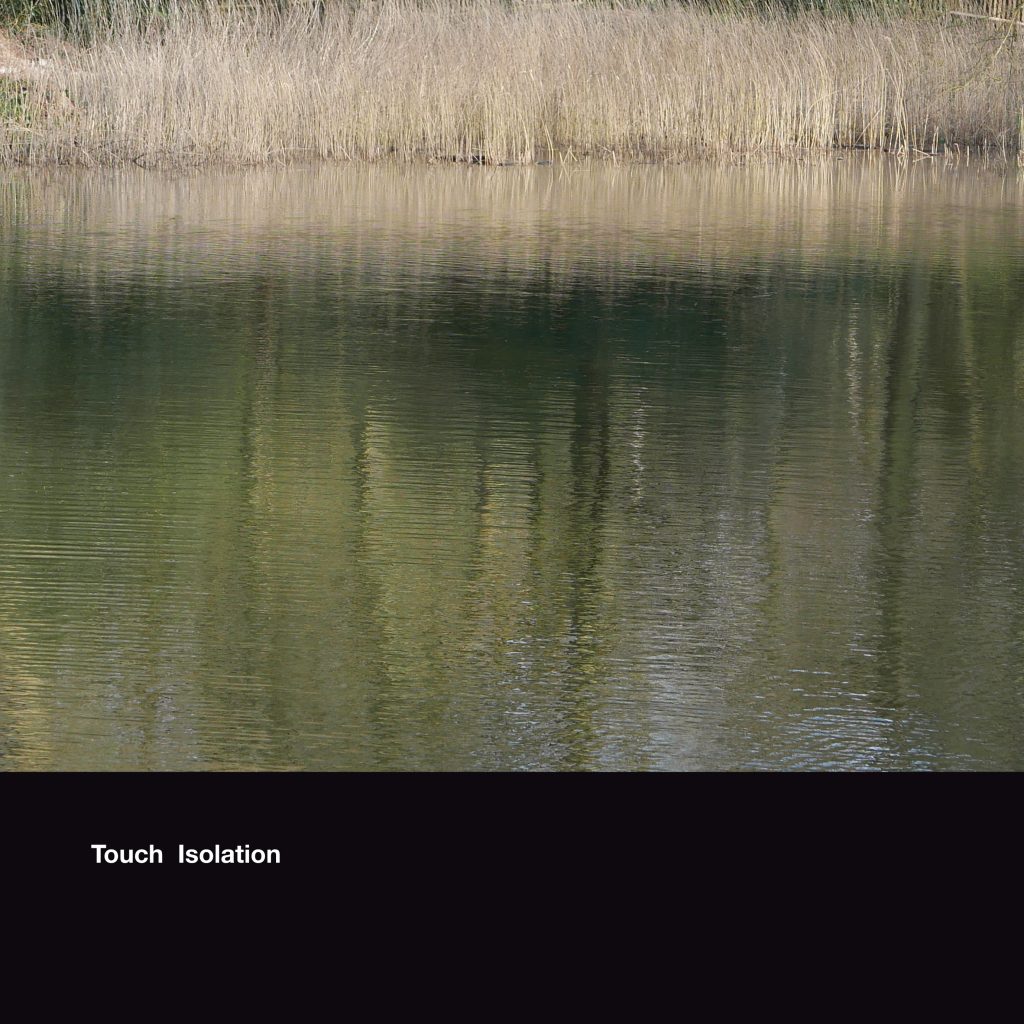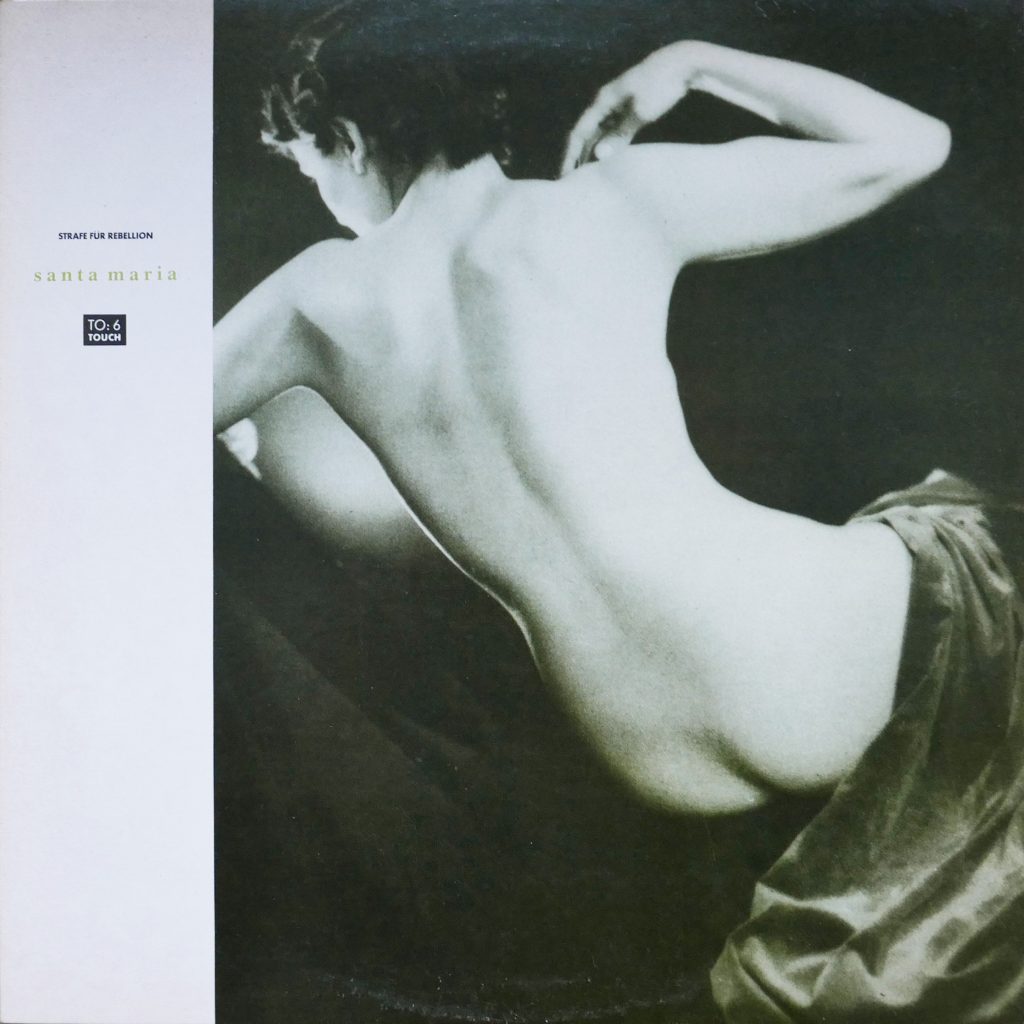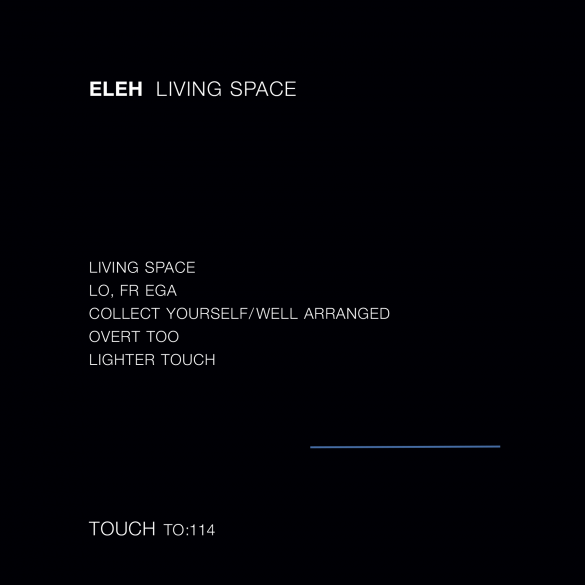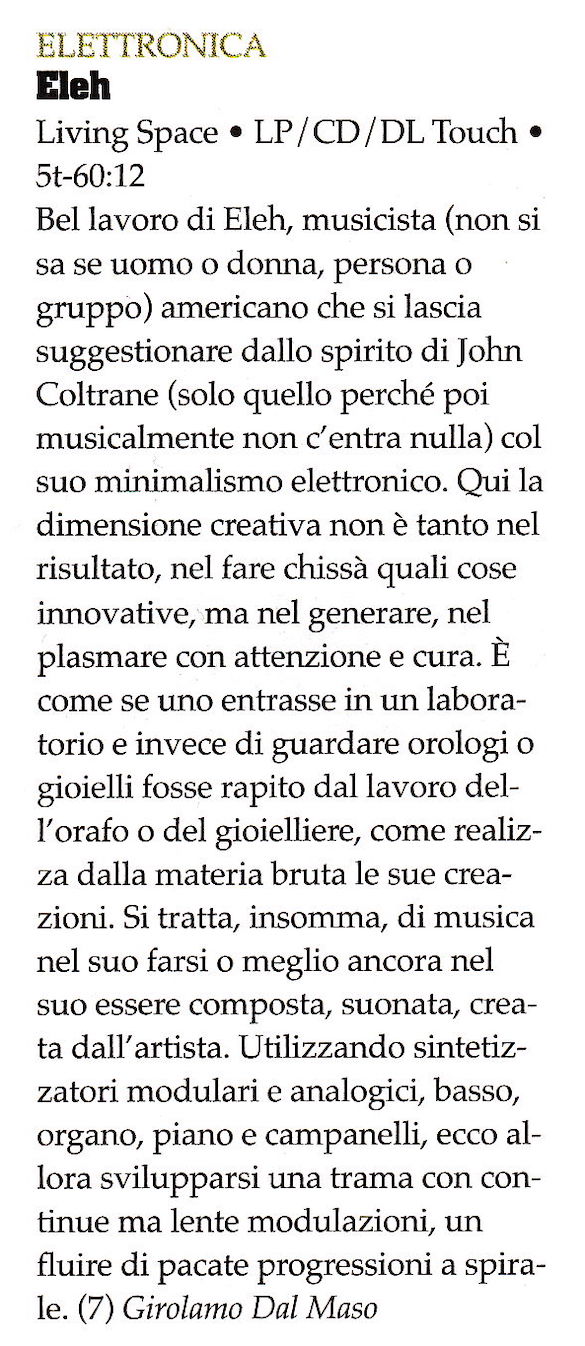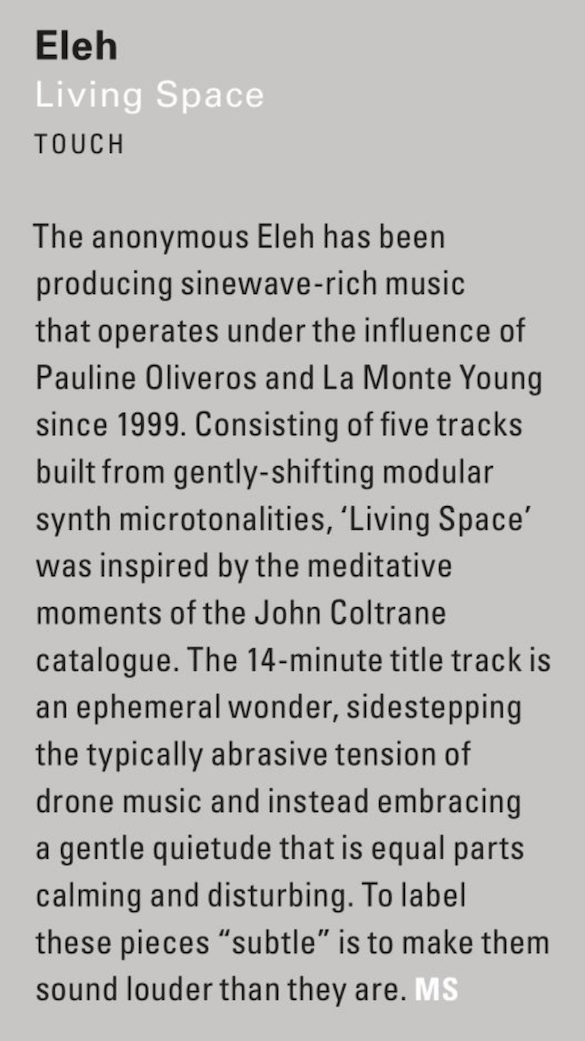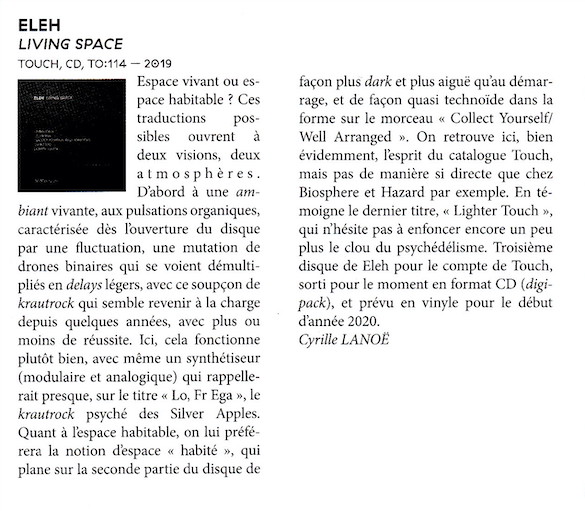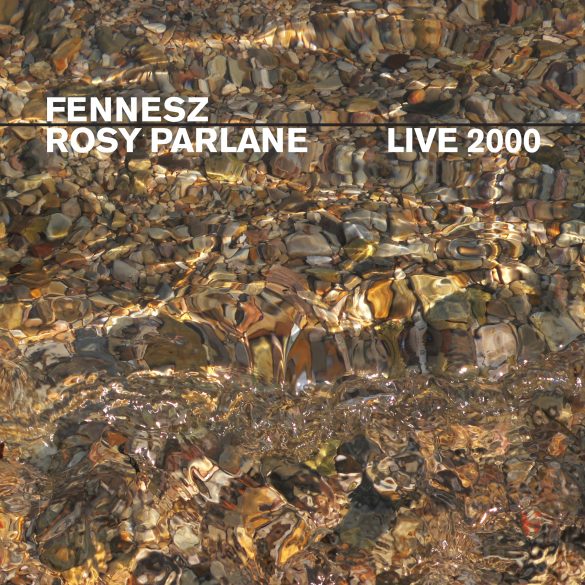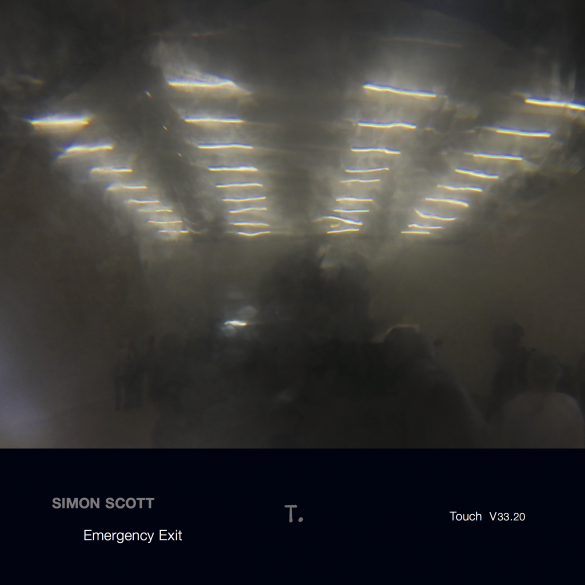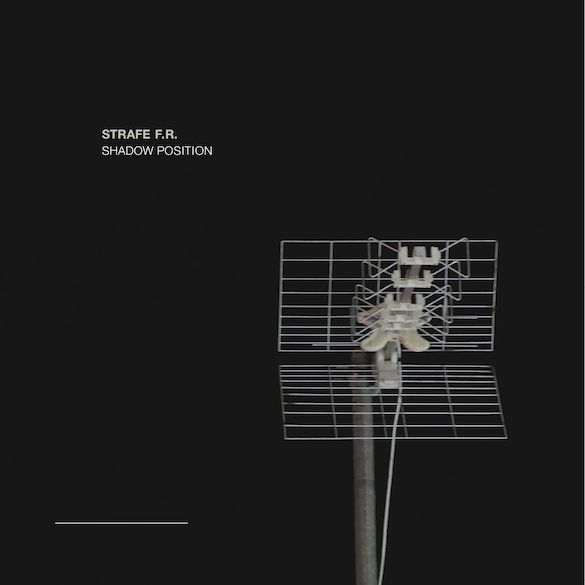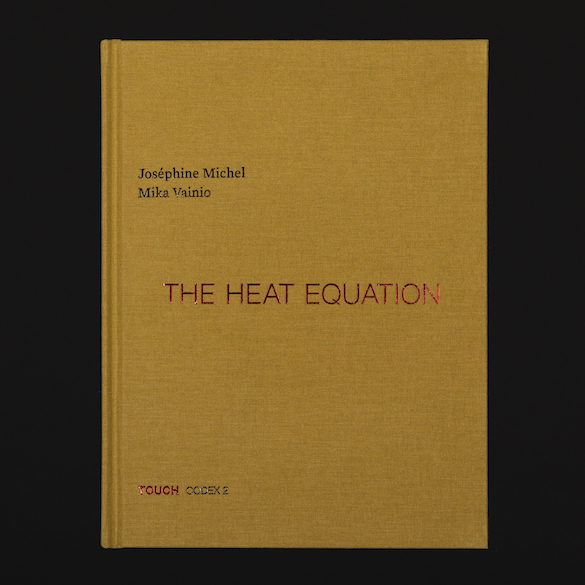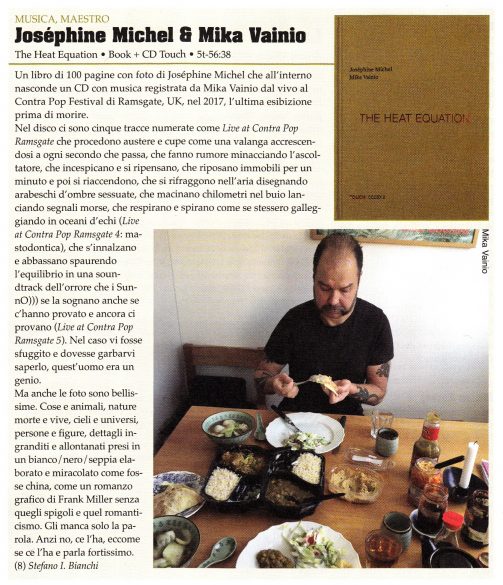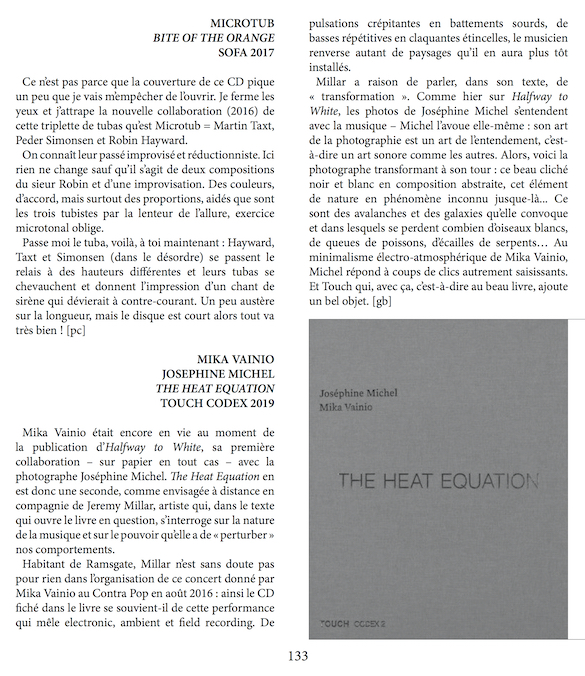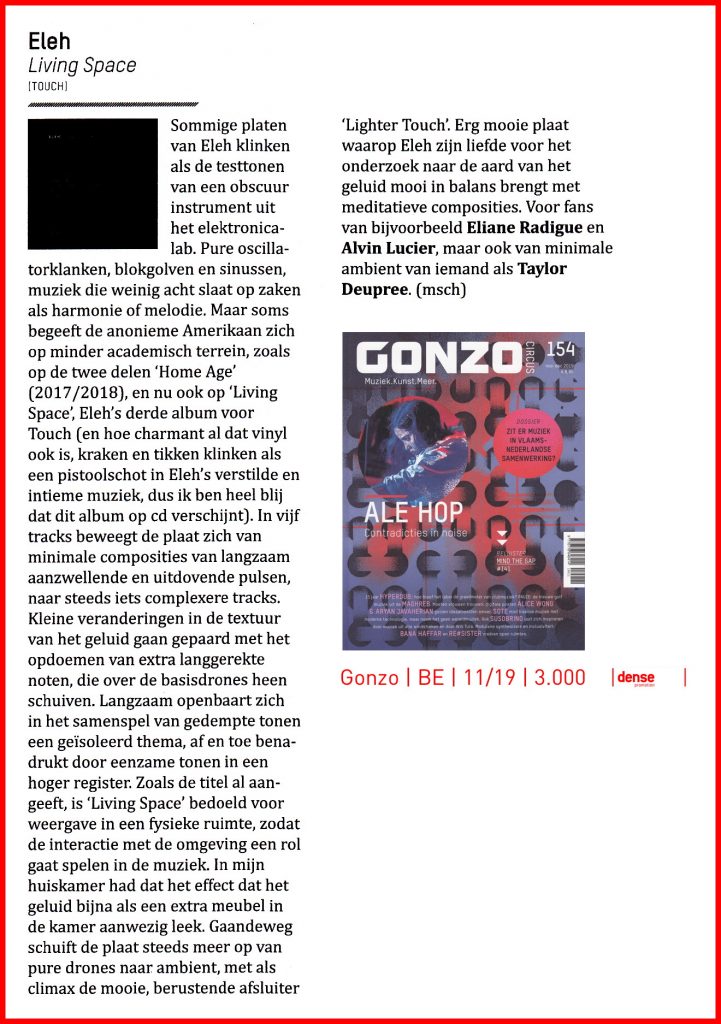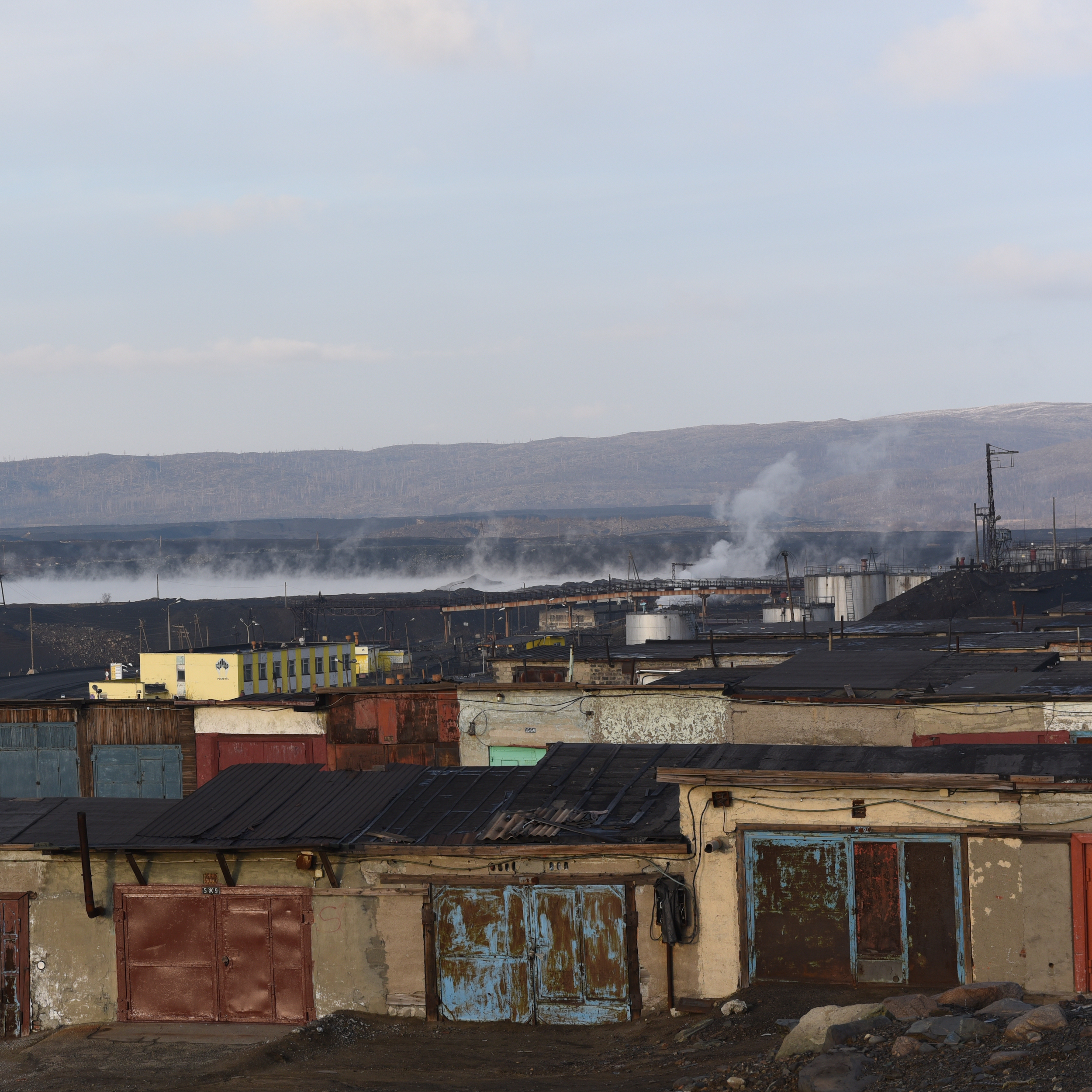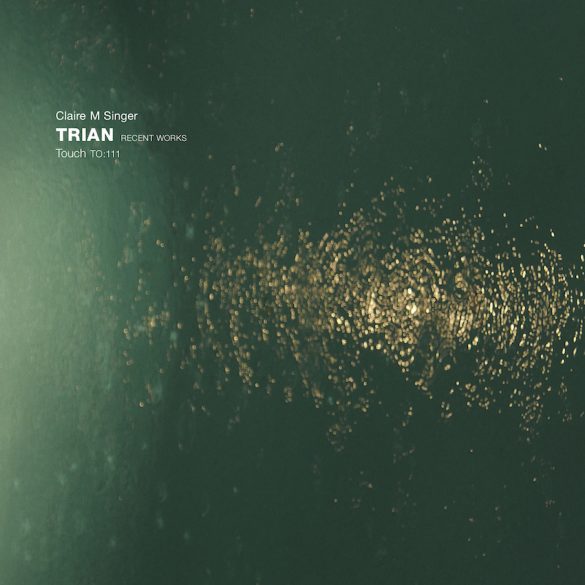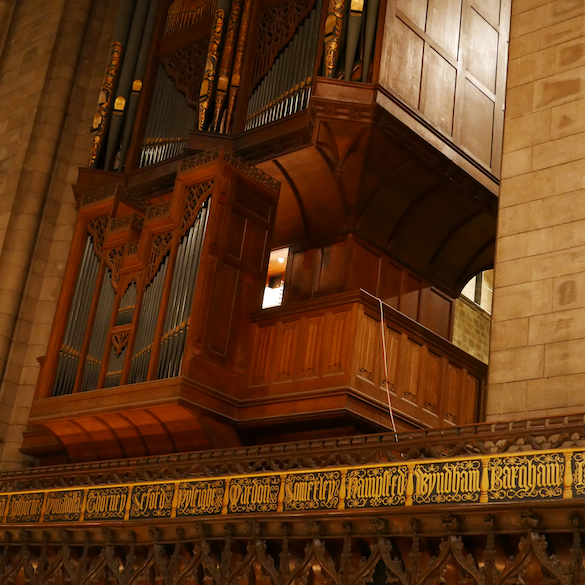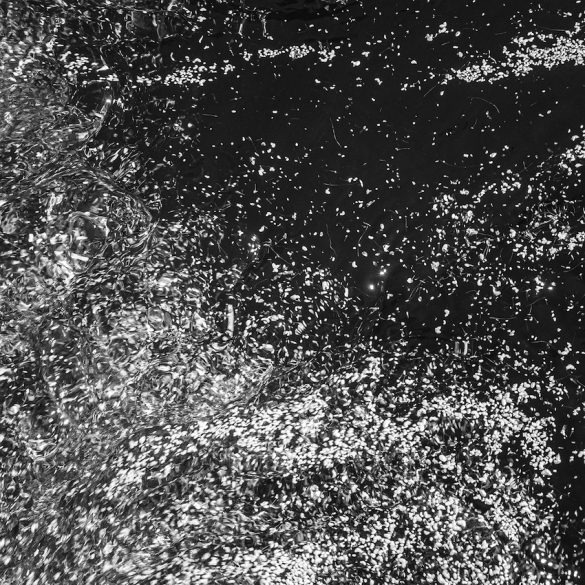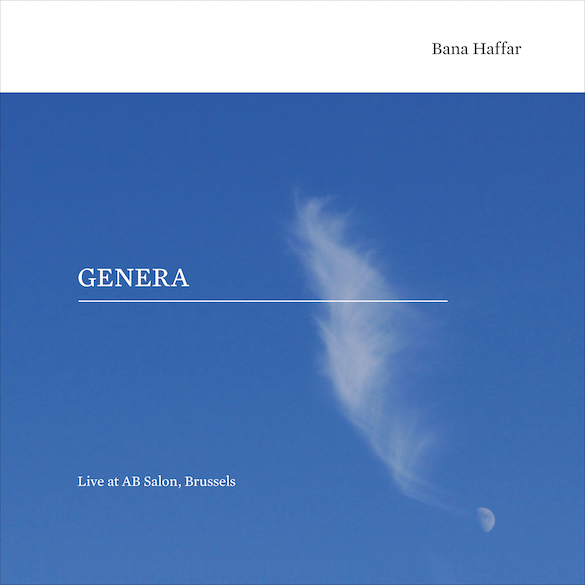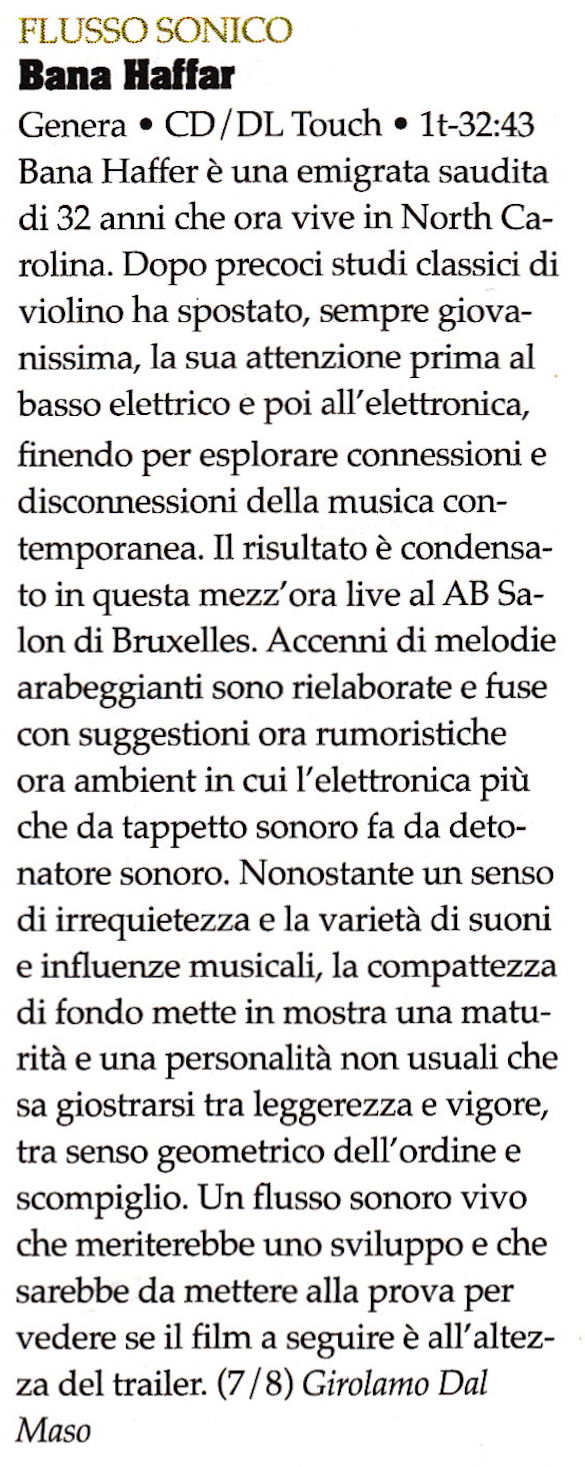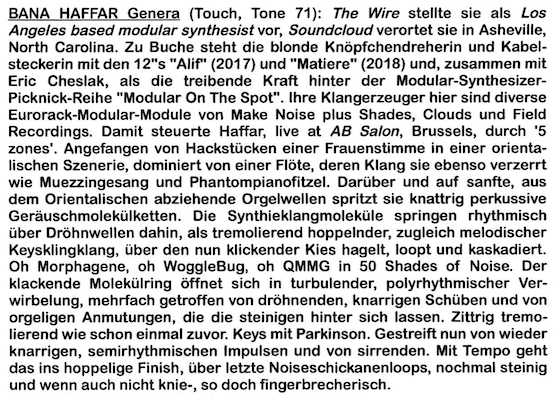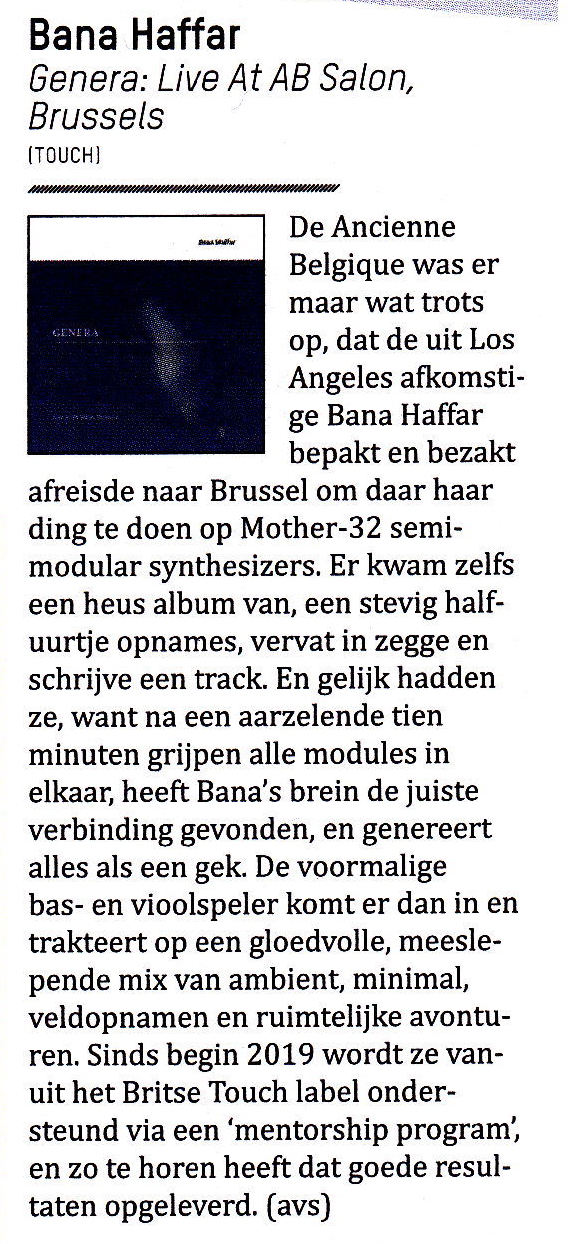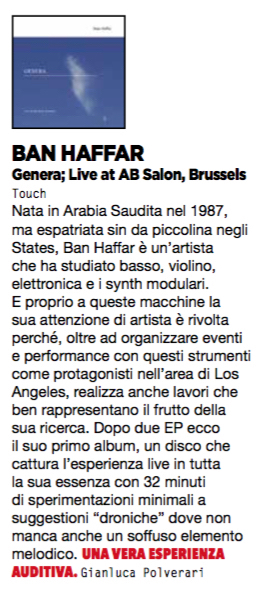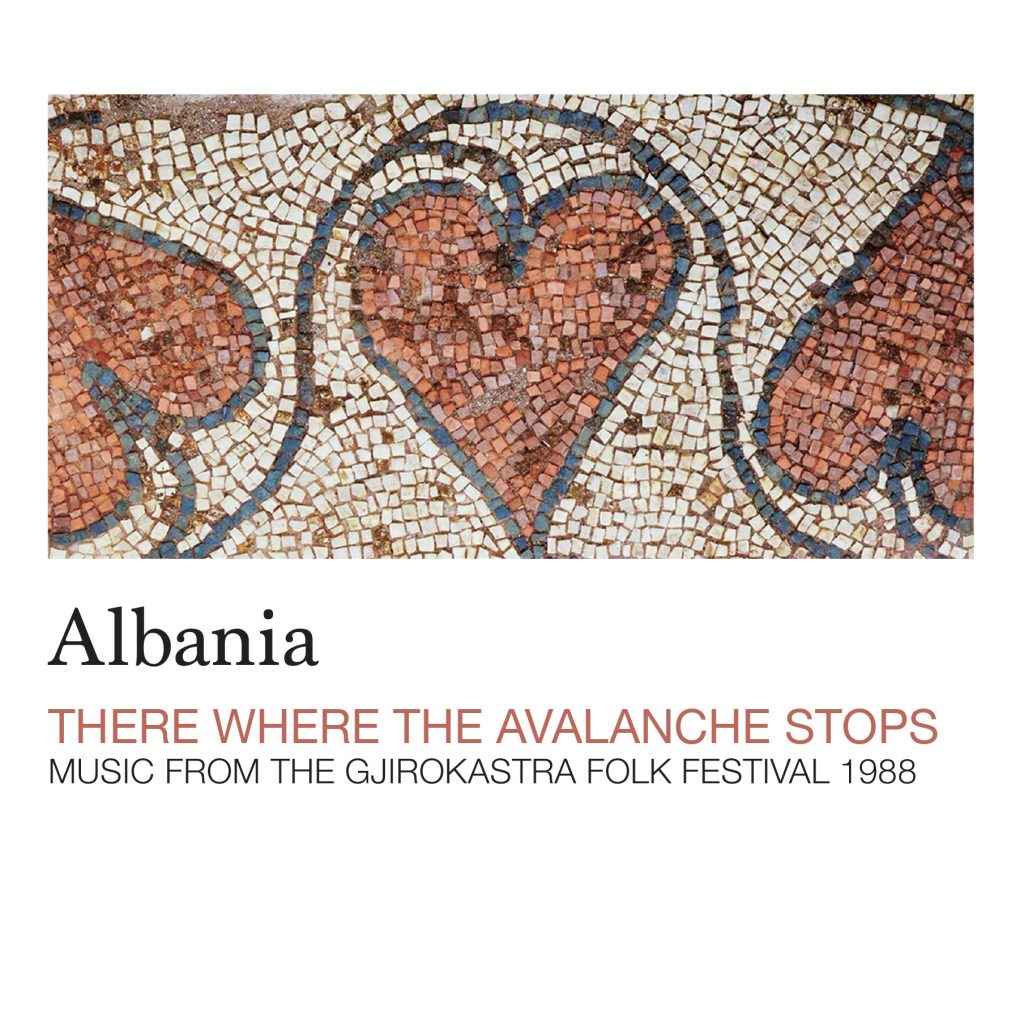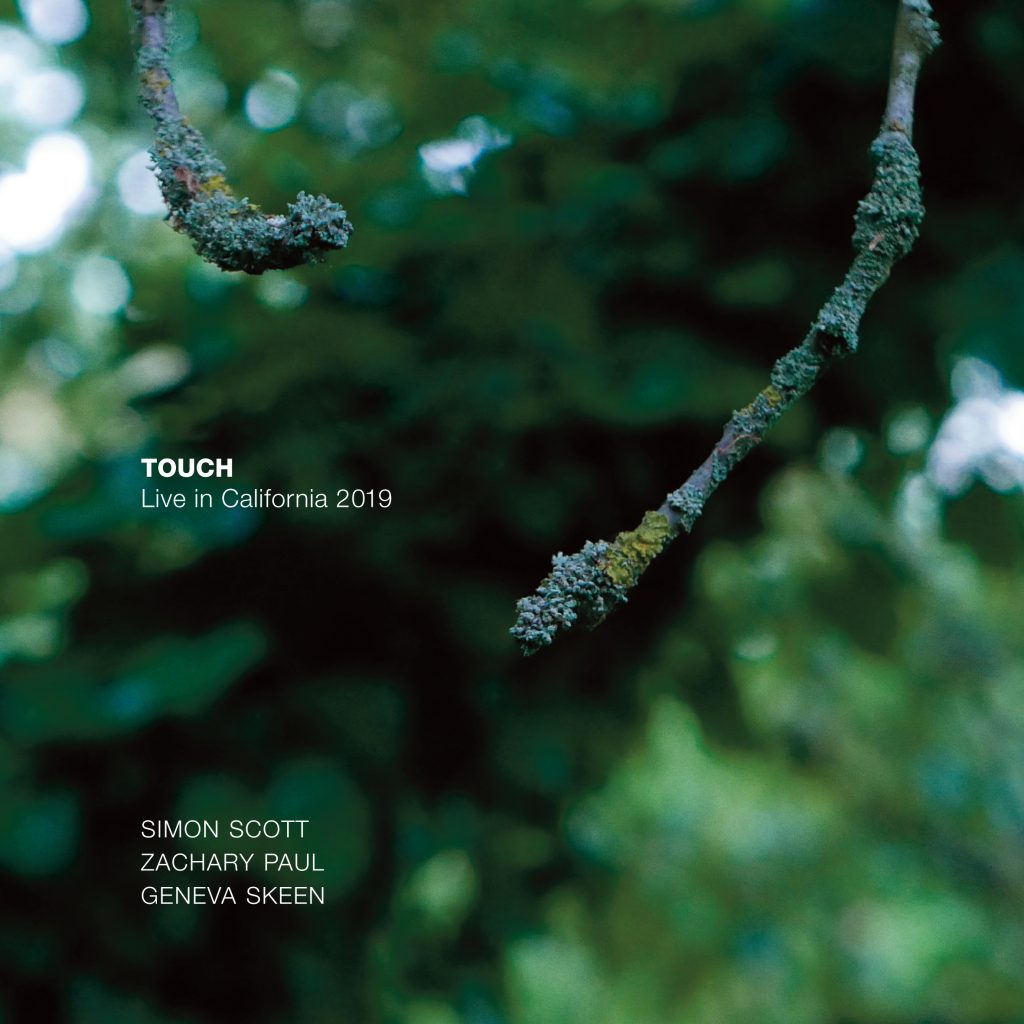Reissued 28th February 2020
CD – 3 tracks – 77:49
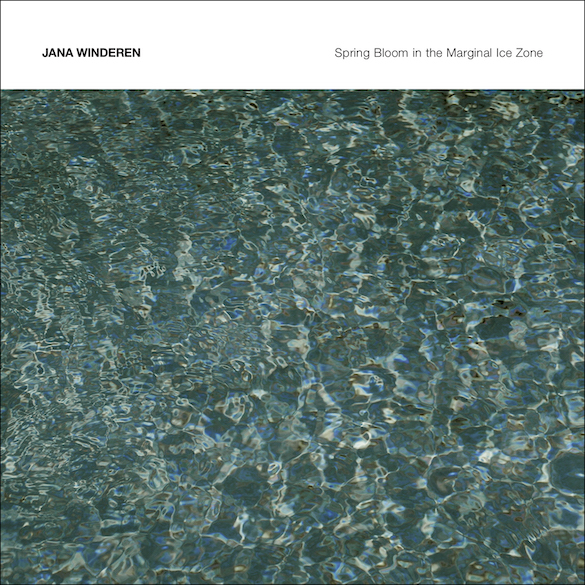
Spring Bloom in the Marginal Ice Zone by Jana Winderen
Track listing:
1. Interview with Carlos Duarte 5:48
2. Spring Bloom in the Marginal Ice Zone – Headphones mix 37:00
3. Spring Bloom in the Marginal Ice Zone – Speakers mix 35:00
You can listen an extract here
The marginal ice zone is the dynamic border between the open sea and the sea ice, which is ecologically extremely vulnerable. The phytoplankton present in the sea produces half of the oxygen on the planet. During spring, this zone is the most important CO2 sink in our biosphere. In Spring Bloom in the Marginal Ice Zone the sounds of the living creatures become a voice in the current political debate concerning the official definition of the location of the ice edge.
The listener experiences the bloom of plankton, the shifting and crackling sea ice in the Barents Sea around Spitsbergen, towards the North Pole, and the underwater sounds made by bearded seals, migrating species such as humpbacks and orcas, and the sound made by hunting saithe, crustaceans and spawning cod, all depending on the spring bloom.
Spring Bloom in the Marginal Ice Zone is a Sonic Acts and Dark Ecology commission first shown as a 7 channel installation at the Sonic Acts festival (Muziekgebouw, Amsterdam, 2017). It was supported by Art & Technology – Arts Council Norway, Fond for lyd og bilde, Tono stipendet, ARCEx research cruise on R/V Helmer Hanssen, UiT The Arctic University of Norway. Thanks to Paul Wassmann, Ingrid Wiedmann, Britt Kramvig, Berit Kristoffersen, Hilde Methi, Annette Wolfsberger, North Sailing, Arctic Encounters, Mamont Foundation & TBA21 Academy.
CARLOS M. DUARTE is Professor of Marine Science, Tarek Ahmed Juffali Research Chair in Red Sea Ecology, Biological and Environmental Science and Engineering Division, and is a world-wide leader in multiple branches of biological oceanography and marine ecology.
PHILIPP ASSMY is a researcher at The Norwegian Polar Institute, Tromsø, Norway. Current activities include species-specific studies of planktonic and sympagic communities and primary productivity in the Arctic Ocean north of Svalbard. He is also studying the impact of changing sea ice conditions and associated effects (e.g. changes in light climate and surface stratification) on phytoplankton and ice algal communities.
Artwork & photography by Jon Wozencroft
Booklet photography by Philipp Assmy
Mastered by Denis Blackham, Skye
Reviews
Rockerilla (Italy):
Ancora un esempio di soundscaping, essenziale e importante opera divulgativa. Jana Winderen è diplomata in Belle Arti con conoscenze approfondite in matematica, chimica ed ecologia marina. In questo lavoro si è occupata del fragile equilibrio cheesiste lungo la linea di confine che divide il mare aperto e ledistese di ghiaccio, un luogo che permette la creazione del vitale serbatoio di ossigeno della biosfera. Spring Bloom é un rilevante lavoro che unisce cultura ecologica ed espressività artistica grazie a due lunghi episodi immersivi nei quali è stata utilizzata tuttal’intensità e la drammaticità del field recording. NECESSARIO. [Mirco Salvadori]
Chain DLK (USA):
Layering high-latitude field recordings of the border between sea ice and the open sea into one found sound composition, this is an elegant work with a lot of fascinating detail. While there’s underwater seal and whale sounds (mostly faint), it’s never in danger of becoming a relaxation cliché, mainly thanks to the crisp and almost electronica-like noises of the ice itself, which are gentle but still slightly alienating, and which ebb alternatively with windier, quite barren sounds.
There’s a 37-minute ‘headphones mix’ and a 35-minute ‘speakers mix’. I didn’t compare or side-by-side them, instead being perfectly happy with a 72-minute listening experience that didn’t overstay its welcome.
It’s framed in terms of marine science and ecology rather than art, nevertheless it’s a beautiful thing to listen to, toeing an unusual line between emptiness and grandeur that really draws you in.
Toneshift (Italy):
With this record the acclaimed biologist (Really? – ed.) and sound artist Jana Winderen adds another valuable work to the continuum of her personal research. Differently enough from her previous output, Spring Bloom in the Marginal Ice Zone engages with the political aspects of climate change in a much stronger and direct way. A strong bond from both a scientific and an sensitive link to the catastrophic effects of global warming becoming everyday much more evident (I’m now sitting in my kitchen in Oslo, it’s mid-November and the temperature of 9°C is just insane for this period of the year). While on the other side new capitalism-led far right movements getting into power worldwide pretend nothing happens, Winderen frames out a specific picture, a well-defined endangered natural phenomenon that becomes an example of the possible consequences for our society’s behaviour.
Part of her statement comes from the first document contained in the record: an interview with the professor Carlos Duarte that explains in great detail how marine spring bloom in the marginal ice zone happens and how it is fundamental for the life cycle, not only of the creatures inhabiting the polar sea, but for the entire world.
The Marginal Ice zone is that belt in which the transition between the ocean and the sea ice happens – and where the algae that in the months right after the polar night accomplish their life cycle, not only represent the main food resource for plankton and other small sea creatures, which become food for other species in their turn, but also act as the biggest sink for carbon dioxide in our biosphere.
From a visual perspective this photosynthetic blast appears like a green wave that moves between spring and summer from the lowest latitudes to the highest ones.
The album contains then two different renders of the same track, a headphone mix and a speaker mix. This was for me a very nice surprise that I considered a natural aesthetic consequence for a sound specialist, aware of the fact that more and more people around the world listen to music mainly over headphones. The sense of presence and immersiveness we gain from the binaural mix is a feature not to be overlooked. It contributes a lot to the experience of this ever-changing perfect orchestra that nature is.
No digital granulation process could possibly ever match the beauty and the richness of the granular sounds happening in nature. The sound materials in the record, all coming from field recordings of the environment and the species inhabiting the area around Spitsbergen in the Barents Sea, provide the feeling of being part of the ecosystem that we can’t then perceive as something away from us anymore. [Giuseppe Pisano]
Touching Extremes (Italy):
Jana Winderen belongs in my mnemonic list of trustworthy researchers. Spring Bloom In The Marginal Ice Zone confirms that the Norwegian is second to none as far as releasing materials of acoustic and learning relevance is concerned. That Winderen mostly focuses her investigations on the usually disguised characteristics of marine biology is a major plus for a person – yours truly – who considers the sea as his one and only teacher. What happens in there, and in the immediate surroundings, can’t possibly be rendered by words; perhaps not even by a detailed recording like this. Nevertheless, identifying the essence of our animateness in the absence of mind-poisoning ‘explanations’ is a motivation. All it takes is listening, leaving the narrative to the evolved segments of creation.
I didn’t pick the ‘evolved’ adjective casually. The two versions of this piece, originally born as a 7-channel installation for the 2017 edition of the Sonic Arts festival in Amsterdam, indicate the voices of whales, seals, crustaceans, pollock and whatever is imaginable underwater as the closest thing to a technically advanced, and inevitably efficient human instrument. In this case, ‘human’ means that – at the same time – we are kept responsive in spite of today’s sickening depreciation of anything which is really important, while remaining pitifully insufficient in regard to a multitude of bottomless meanings appearing to these ears as organic variations on hypothetical themes. The latter have to do with the inscrutable aspects of perception that, in the past, were brought out by the intuitions of genuine visionaries such as Tod Dockstader and Roland Kayn. The impact of this experience on the innermost self is often equivalent: just standing in quietness, surrounded by inexpressible beauty without dull-witted interrogatives about why, when, what comes after. Harmonic auroras speckled by a myriad of invisible lives, forever more consequential than the arid loquaciousness of many a deleterious nonsense huckster.
The music’s therapeutic effects are striking, especially in ‘full immersion’ mode (no pun intended). A brief explanatory interview with Professor Carlos Duarte, a renowned luminary of biological oceanography, represents a fitting preamble. However, what Winderen managed once again to extrapolate from the apparent obscurity is a current of awareness that defeats any activist’s speech. We keep witnessing natural disasters on a daily basis, but the energy of those creatures remains. Mute choirs that still sound marvellous, thanks to a woman who keeps reminding us of their lessons. The real ones. [Massimo Ricci]
Czech National Radio:
Hudební abstrakce může být někdy úzce spjatá s konkrétním a naléhavým tématem doby. Můžeme tomu říkat hudba, nebo zvukové umění, nebo jakkoli jinak: Na každý pád novou nahrávkou Norky Jany Winderen pokračuje její dlouhodobý průzkum podmořských zvuků. Album Spring Bloom in the Marginal Ice Zone (Jarní květ v marginální ledové zóně) lze zároveň poslouchat jako komentář k diskusi o budoucnu Země.
Posluchač tu vnímá zvuk kvetoucího planktonu, vlny a praskot ker v ledovém Barentsově moři kolem Špicberků směrem k severnímu pólu, a také podvodní zvuky tuleňů vousatých, migrujících keporkaků a kosatek, stejně jako zvuk táhnoucího hejna tresek. Všechno tohle dění podle Jany Winderen souvisí s jarem v moři, oním kvetoucím planktonem. Marginální ledová zóna je termín pro pohyblivou hranici mezi otevřeným a zmrzlým mořem, což je ekologicky velmi zranitelná zóna. Fytoplankton přítomný v moři produkuje polovinu, celou polovinu zemského kyslíku. A na jaře je tato sféra nejvýznamnějším likvidátorem oxidu uhličitého v naší biosféře. Takže zase: odposlech skutečného světa jako svědectví o prostředí, na kterém budoucnost země závisí těsněji, než si připouštíme. Jana Winderen píše: ‘Na nahrávce Jarní květ v marginální ledové zóně se stává zvuk živočichů hlasem v aktuální politické debatě na téma oficiální definice této zóny na pokraji ledovce.’ [Pavel Klusak]
Music Map (Italy):
‘There’s no way we can stop that.’ Queste sono le drammatiche parole di Carlos Duarte, ecologista esperto di vita marina e di biologia oceanografica, riferendosi allo scioglimento dei ghiacciai nell’Artico. Estratte da un’intervista, dove si parla di diossido di carbonio, ecosistema, neve che scompare, Duarte ci avverte che il processo del riscaldamento globale è ormai irreversibile, e quello che possiamo fare oggi è solo imparare a convivere con l’imminente cambiamento climatico. Questo si sposa con la filosofia della Dark Ecology, un movimento ecologista ‘decadentista’ fondato da Timothy Morton. Il suo approccio, più che razionale, vuole portare i propri lettori e seguaci ad una partecipazione emotiva, nell’affrontare il punto di vista ecologista. E fa qualcosa che va oltre (o accanto) l’attivismo concreto. Per questo scopo emozionale, la Dark Ecology assieme a Sonic Acts hanno commissionato questo lavoro di sound art a Jana Winderen, intitolato Spring Bloom in the Marginal Ice Zone ed appena uscito per Touch. La quale, già esperta di ambienti freddi (vedasi Interrupting the surface del 2014), si è diretta nel mare di Barents, che sta fra Norvegia e Russia, appena sotto il Polo Nord.
Ha posizionato i suoi microfoni sott’acqua, facendoci scoprire un mondo di suoni a noi sconosciuti. Per noi l’oceano è silenzioso, poiché percepiamo i suoni spostati dall’aria. Ma sott’acqua, gli animali comunicano con vibrazioni che ricevono nelle ossa. E così, grazie alla tecnologia acustica si apre un mondo di rumori sconosciuti, racchiusi in Spring Bloom in the Marginal Ice Zone, che è costituito da tre tracce. La prima è la sopracitata intervista a Carlos Duarte. Il succo sta nell’unica titletrack, sdoppiata per far sentire due differenti mix: ‘Headphone’, e ‘Speakers’. In totale si tratta di quasi 72 minuti in apnea, immersi nel mare, dove ascoltare il ghiaccio che gradualmente si rompe, l’acqua che gocciola o che trasporta i rimbombi, e le comunicazioni fra merluzzi, crostacei, balene ed orche. I pesci non arrivano a intervalli regolari, non c’è struttura musicale.
Quando passano vicino ce ne accorgiamo, altrimenti restiamo soli fra le onde. Se finora i ‘canti delle balene’ potevano essere una battuta ironica rivolta a certa ‘musica per installazioni’, ascoltando questa ci si può ricredere, e scoprire che gli oceani sono molto più rumorosi di quel che avessimo potuto pensare. E Jana, con il lavoro in post produzione, non snatura le peculiarità naturalistiche delle registrazioni, ma gioca con i rumori di fondo per renderli come fossero inquietanti drones. E così, rendendoli una sorta di minaccia verso questo vivace mondo blu, ci fa riflettere. [Gilberto Ongaro]
Bad Alchemy (Germany):
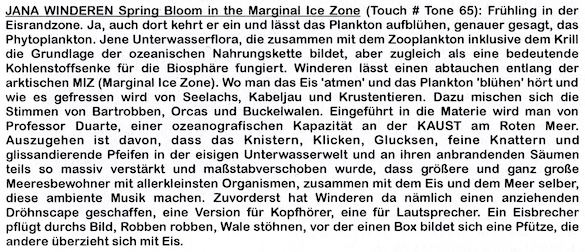
The Wire (UK):
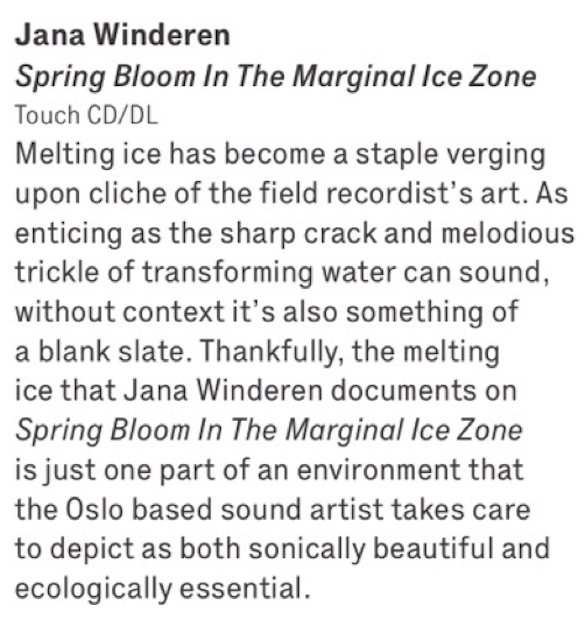

CLOT Magazine (UK):
The marginal ice zone is the dynamic border between the open sea and the sea ice, which is ecologically extremely vulnerable. The phytoplankton present in the sea produces half of the oxygen on the planet. During spring, this zone is the most important CO2 sink in our biosphere. An algal bloom or algae bloom is a rapid increase or accumulation in the population of algae in freshwater or marine water systems and is recognized by the discolouration in the water from their pigments. The proliferation of algal blooms likely result from a combination of environmental factors and the rise of temperatures in spring is one of the driving force.
Field recorder Jana Winderen has been documenting the sounds of underwater life in our seas and oceans – from the warm waters in the Caribbean to the cold and nourishing waters around Greenland, Norway and Iceland, creating the most beautiful compositions out of them. She researches the hidden depths with the latest technology with her work revealing the complexity and strangeness of the unseen world beneath.
Spring Bloom in the Marginal Ice Zone is Winderen’s latest instalment in the series of works exploring these underwater sounds. A commission by Sonic Acts and Dark Ecology, it resulted in an installation for the ‘Sonic Acts Festival’ in 2017. The listener or viewer experiences the bloom of plankton, the shifting and crackling sea ice in the Barents Sea around Spitsbergen, towards the North Pole, and the underwater sounds made by bearded seals, migrating species such as humpbacks and orcas, and the sound made by hunting seithe and spawning cod, all depending on the spring bloom.
The work was produced with help of Carlos M. Duarte, a Professor of Marine Science, and a worldwide leader in multiple branches of biological oceanography and marine ecology. Philipp Assmy is a researcher at The Norwegian Polar Institute, Tromsø, Norway, currently studying the impact of changing sea ice conditions and associated effects on phytoplankton and ice algal communities.
In November 2018, an edit of the recordings was released on Touch. The album starts with an introductory interview with Carlos Duarte, where he explains with some scientific details the occurrence of the algae blooms in the region. The other 2 tracks are long meditative pieces, with the chirps, drips and squeaks of marine life and the shoosh of waves and wind. In this piece of work, a most timely release in view of the recent UN Climate Change report, Winderen is offering another compelling reflection on the fragility of these delicate marine ecosystems and somehow as well, the sounds of the living creatures become a voice in the current political debate concerning the official definition of the location of the ice edge.
Rockdelux (Spain):

Gonzo Circus (Belgium):
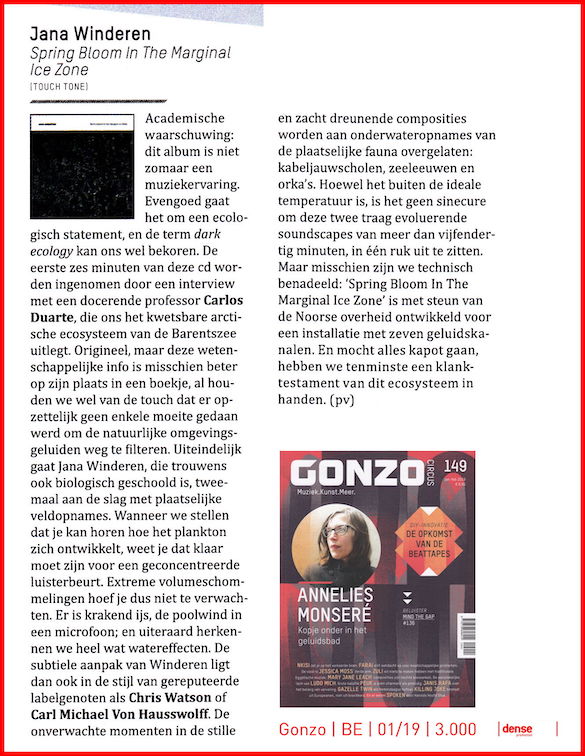
Nordische Musik (Norway):
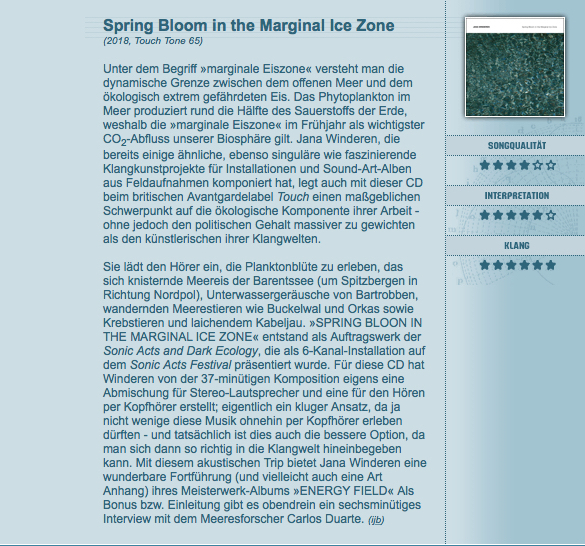
Neural (Italy):
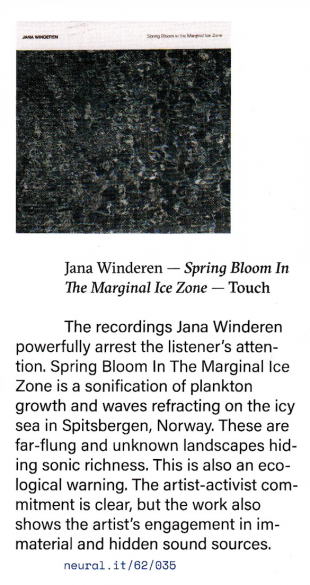
Neural (Italy):
The recordings Jana Winderen made here for Touch powerfully arrest the listener’s attention. They are an accurate sound reportage of plankton growth, of the waves refracting on the iced sea and its crackles. We are in Spitsbergen (Norway), the largest island of the Svalbard archipelago on the way to the North Pole, between bearded seals and other weird migratory species like humpback whales and killer whales. Most of what happens in that delicate geographical area depends on the results of the Spring growth. The definition of marginal zone, where the dynamic boundary is limited within the open sea and the sea ice, clearly explains how this land is ecologically vulnerable. The specialists explain that the phytoplankton in the sea produces more or less half of the oxygen of the planet and, during the Spring, this zone is the most important source of CO2 in our biosphere.
In Spring Bloom In The Marginal Ice Zone, these sounds, including the few ones the creatures who live there make, ideally become a warning for whoever focuses on these ecological themes. We shouldn’t be surprised, therefore, that the first track is an interview with Carlos Duarte, Professor at King Abdullah University of Science and Technology, a world renowned figure in many branches of oceanography and sea ecology.
It is not the first time Jana Winderen has evoked the charm of underwater life. This is just the latest release in a series of works focusing on sea environments and ecosystems, a broad range of far-flung locations from the Caribbean to Greenland, from Norway to Iceland. The artist’s activist commitment is clear here, but the work also shows the artist’s engagement in the immateriality of sound and how her projects are focused on exploring hidden and unusual sources. These are places and sound landscapes that are hard to access and mostly unknown, but they hide a great variety of audio inspirations the artist uses as source material for live ambient compositions and to create immersive installations. Spring Bloom in the Marginal Ice Zone is a project commissioned by Sonic Acts and Dark Ecology, supported by Art & Technology – Arts Council Norway, Fond for lyd og bilde, Tono stipendet, ARCEx R / V Helmer Hanssen, by Tromsø Univesity and by Foundation Mamont. The elegant, colourful artwork and the interesting photo booklet are made by Jon Wozencroft. [Aurelio Cianciotta]
